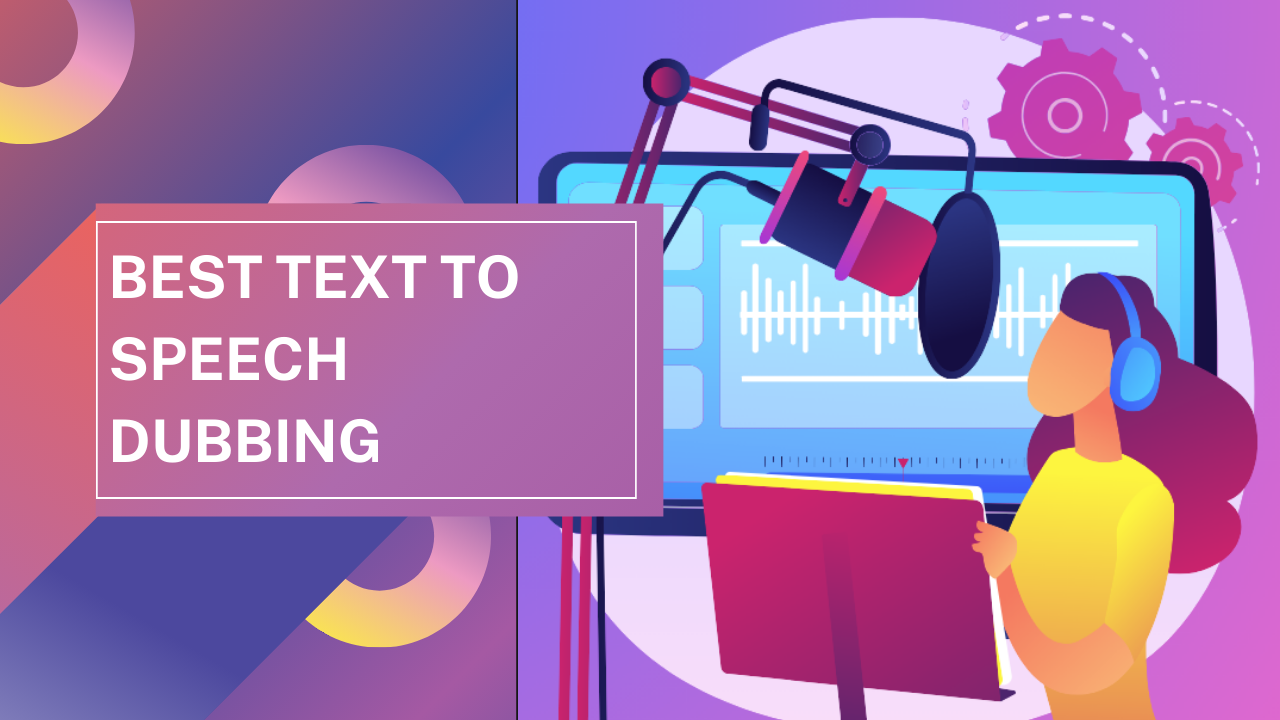Text-to-speech technology has revolutionized the dubbing industry, making it more accessible and efficient. Among the various options available, the top 5 best text-to-speech tools for dubbing stand out for their quality and user-friendliness.
In this article, we will discuss these leading tools, exploring their features, benefits, and how they can enhance your dubbing projects. Whether you’re a professional or just starting out, understanding these tools can significantly improve your workflow.
Top 5 Best Text To Speech For Dubbing
1. TextoSpeech
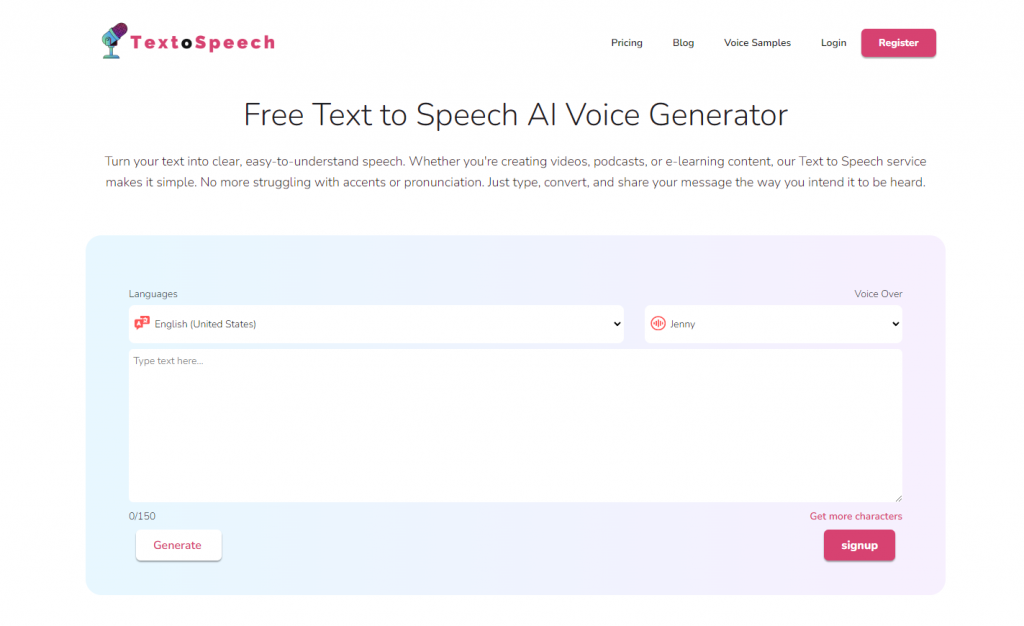
TextoSpeech is a text-to-speech tool that’s great for dubbing videos. It turns written text into spoken words. This is handy if you want to add voice to your videos without recording it yourself.
The tool offers different voices. You can choose one that fits your video style. It’s like having a range of actors ready to speak your script. This adds a professional touch to your dubbing.
Using TextoSpeech is simple. You type or paste your script, pick a voice, and the tool does the rest. It’s fast and doesn’t need any special skills. This makes it a top choice for quick and easy video dubbing.
Features of TextoSpeech
- Supports over 50 languages and 300 voices, providing a diverse range of content needs.
- Provides an easy-to-use text editor with real-time preview for fine-tuning voiceovers.
- Flexible pricing plans, including a free version, low-cost subscription options for advanced features, and a lifetime plan.
- Natural-sounding voices that are ideal for YouTube videos and multimedia projects.
- Web-based platform, ensuring accessibility and convenience without the need for software installation.
- Fast processing speeds allow for faster turnaround on voiceover projects, increasing productivity.
Pros and cons of TextoSpeech
Pros
- Variety of Voices and Languages
- Ease of Use
- Time-Saving
- Cost-Effective
- Consistency
- Accessibility
Cons
- Limited Features in Free Version
- Lack of offline functionality
2. MicMonster

MicMonster provides high-quality text to speech voices that can be used for dubbing videos or audio projects. The voices sound very natural and humanlike.
There are multiple realistic male and female voice options with various language and accent availability. You simply enter your script and MicMonster generates a professional voice recording reading your text aloud.
MicMonster offers an easy and cost-effective text to speech solution to dub existing videos and audio. The natural-sounding vocal recordings can be added seamlessly to replace the original narration. It’s an ideal option for dubbing all types of content.
Features
- Over 600 voices are available, covering 140 languages and catering to diverse linguistic needs.
- Advanced AI technology enables it to infuse emotions into voiceovers, adding authenticity and reliability.
- UMicMonster offers natural, human-like voices.
- Delivers exceptional audio quality with a 384 Kbps Bitrate for an immersive listening experience.
- Offers control over the emotion and tone of voiceovers, enhancing realism and engagement.
- Allows flexibility in adjusting pitch and speed to suit specific project contexts.
Pros and Cons
Pros
- Wide Range of Voices and Languages
- User-Friendly Interface
- Speed of Conversion
- Customization
Cons
- Lack of Natural-Sounding Voices
- Limited Emotional Range
- Contextual Limitations
3. Elevenlabs
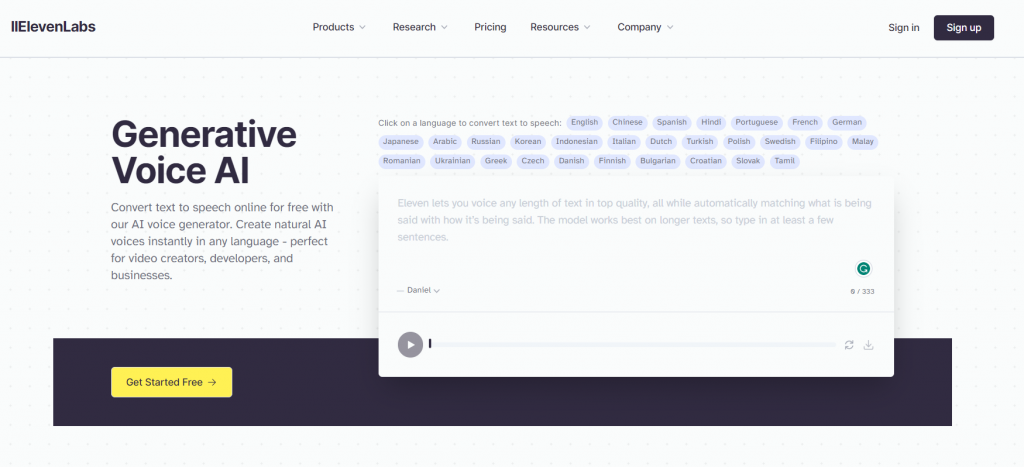
ElevenLabs offers advanced text to speech perfect for dubbing videos or audio files. The voices sound exceptionally realistic and humanlike. There are many natural male and female voice options with different language and accent availability.
The high-quality vocal recordings make it easy to affordably dub animated videos, interviews, documentaries, speeches, and other content. Without needing to re-record voice talent, you can simply use Elevenlabs’ humanlike TTS voices to replace the existing narration.
Elevenlabs provides a convenient text to speech solution for dubbing all types of audio/video content. The computer-generated voices flow naturally and sound very human.
Features
- Generates high-quality audio from text using AI algorithms.
- Offers pre-designed voice profiles and the ability to create new voices from audio snippets
- For long-form content creation, such as audiobooks, with contextually-aware voices.
- Translates and preserves original voice characteristics in over 20 languages.
- Utilized by publishers and authors for AI-narrated content.
- Sets rules against misuse, supporting artistic and political speech
Pros and cons
Pros
- Human-Sounding Voices
- Versatile and Realistic AI Speech
- Voice Lab Feature
- High-Quality Audio
- Voice Library
- Intuitive Interface
Cons
- Control over the final aspects
- Huge number of features
- High Learning Curve
4. Narakeet
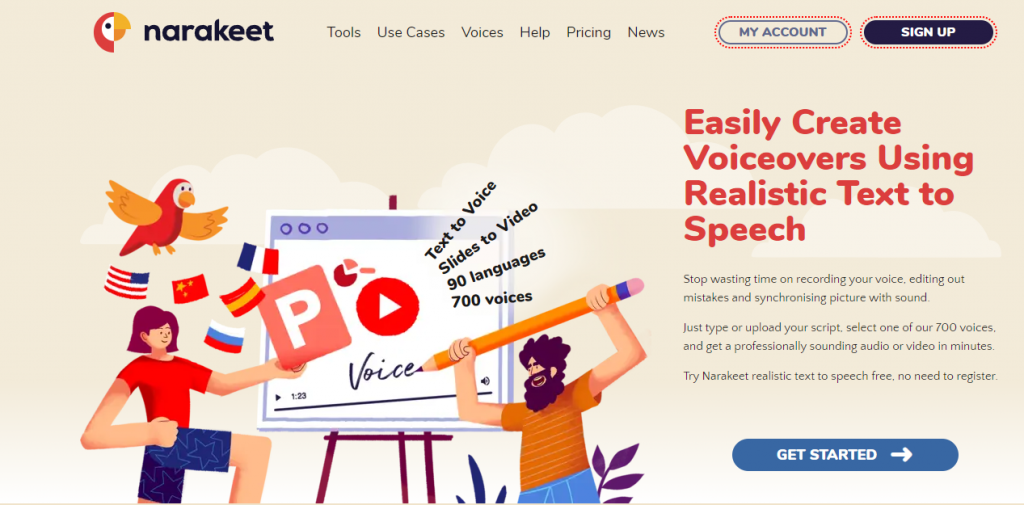
Narakeet Narakeet provides very high-quality text to speech perfect for dubbing all types of videos or audio. The voices sound extremely natural and human-like.
The exceptional voice recordings make it affordable and easy to dub animations, interviews, documentaries, lectures, and other content. Without rerecording voice talent, you can use Narakeet’s TTS to perfectly replace existing vocal tracks.
Narakeet offers a simple text to speech solution for dubbing any audio/video media. The generated voices have flawless pronunciation and sound real. For any dubbing need, Narakeet creates natural human-sounding vocal narration.
Features
- Offers over 700 voices across 90 languages, catering to a global audience and diverse content needs.
- Includes background music options, sound effects, and the ability to adjust speech speed and pitch for customized voiceovers.
- Easy-to-use script editor and the ability to convert PowerPoint presentations directly into narrated videos.
- Flexible pricing plans, including pay-as-you-go and subscription options, are suitable for various user needs and budgets.
- High-quality, natural-sounding voices enhance the overall audio experience of your content.
- Easily integrates with various content creation workflows, streamlining the process of adding voiceovers to videos and presentations.
- Wide accessibility with support for multiple languages and dialects, making it ideal for creating content for international audiences.
Pros and Cons
Pros
- Variety of Voices and Languages
- Ease of Use
- Time-Saving
- Cost-Effective
- Consistency
- Accessibility
Cons
- Limited Features in Free Version
- Lack of offline functionality
5. Murf AI
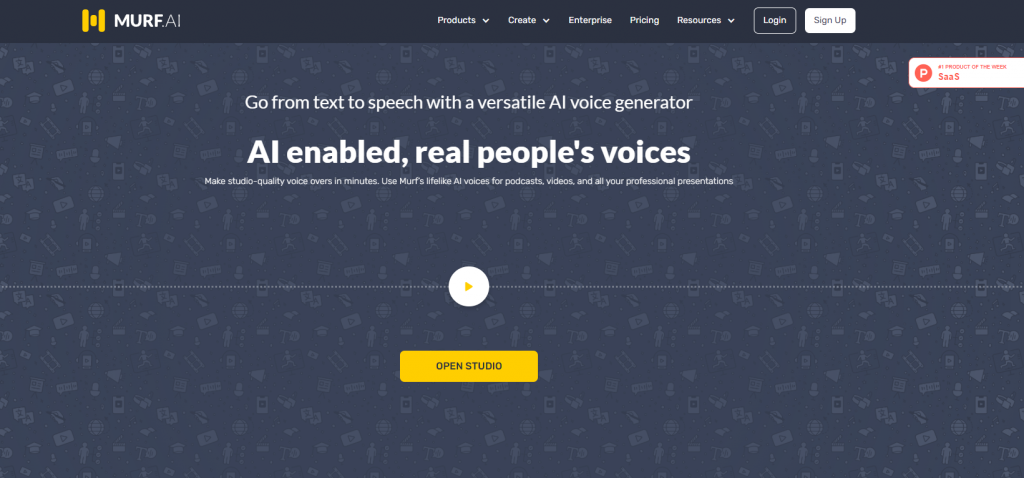
Murf AI Murf AI provides incredibly realistic text to speech voices perfect for dubbing all types of video or audio content. The TTS voices sound flawlessly humanlike.
The exceptionally high quality vocal recordings make it easy and affordable to dub animated films, interviews, lectures, documentaries and more. Without needing to re-record voice talent, you can use Murf AI’s TTS to convincingly replace existing narration.
Murf AI offers the best text to speech solution for dubbing any type of media. The computer-generated vocal recordings sound perfectly human with accurate pronunciation.
Features
- Murf AI offers over 120 voices across 20 different languages, catering to a global user base.
- Includes voice cloning, AI dubbing, and integration with Canva for enhanced voice-over capabilities.
- Advanced text-to-speech editor, voice modulation options, and real-time voice editing for precise control.
- Flexible pricing plans, including a free trial, basic, pro, and enterprise levels, to suit different user needs.
- High-quality, lifelike AI voices are ideal for professional and personal projects.
- User-friendly interface, making it accessible for beginners and experts alike.
- Extensive library of AI voices, including options for different ages, accents, and styles.
Pros and cons
Pros
- Wide variety of voices
- Extra Effects
- Google Slides Add-on
- Performance
- Scalability
Cons
- Cost
- Learning Curve
- Reliability
- Customization
FAQs
What types of content can be dubbed using text to speech?
Text to speech can be used to dub all types of videos and audio including tutorials, interviews, speeches, documentaries, lectures, animated videos, and more. It’s suitable for most dubbing needs.
How realistic do the text to speech voices sound?
With advanced services like Murf AI, Elevenlabs, and Narakeet, the TTS voices sound extremely realistic and humanlike, with natural cadence and accurate pronunciation for dubbing.
Do I need to record real voice actors for dubbing?
No, with today’s high-quality text to speech you can create realistic voice overs for dubbing without needing to hire and record live voice talent.
What accents and languages are available?
Many services offer dozens of voices with numerous accents including US English, British English, Australian, French, German, Italian, and more. Top services also do language translation.
Conclusion
Text to speech technology offers an affordable and efficient solution for dubbing video and audio content. Services like Murf AI, Elevenlabs, and Narakeet provide exceptionally realistic computer-generated voices that sound human.
With just a script, high-quality voiceovers can be created without hiring voice talent. The TextoSpeech tool also offers advanced text to speech suitable for dubbing projects.

